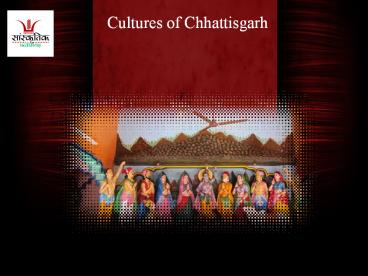Culture of Chhattisgarh - PowerPoint PPT Presentation
Title:
Culture of Chhattisgarh
Description:
The tribal dances represent the rich cultures of Chhattisgarh. Dances are the chief means of the celebration of the tribals. These folk dances also represent the community affairs, characterized by robustness and earthiness. These dance groups are mainly the group dances which involve complex footwork.It is always wonderful to watch the dancers moving are in a line, gyrating in a circle, always in the anti-clock direction. – PowerPoint PPT presentation
Number of Views:10093
Title: Culture of Chhattisgarh
1
Cultures of Chhattisgarh
2
Chhattisgarh is famous for its cultural heritage
and the tribal living there.
3
Chhattisgarh is famous for the rich cultures of
Chhattisgarh amidst crusty cuisine, vivacious
dances, great religions, melodious music, kind
people, amiable languages, sparkling fairs
festivals and marvellous arts crafts. Its
unique approach towards dance, cuisine, and music
which make it different from others.
4
Chhattisgarh is home to a number of types of
tribal in India.
5
It also has India's oldest tribal communities and
the earliest tribals have been living in Bastar
for over 10,000 years. Since the time, the Aryans
occupied the Indian mainland and the rich plains
became war-infested and de-forested for
agriculture.
6
The tribal dances represent the rich cultures of
Chhattisgarh.
7
Dances are the chief means of the celebration of
the tribals. These folk dances also represent the
community affairs, characterized by robustness
and earthiness.
8
The dance groups are mainly the group dances
which involve complex footwork. It is always
wonderful to watch the dancers moving are in a
line, gyrating in a circle, always in the
anti-clock direction.
9
The Maria Tribes are the most spectacular dances.
The men lace a strip of cloth round their torso,
wear head-dresses of peacock and cock feathers,
and tie bells around their wrists and ankles.
Some also wear stag and bison horns on the head.
In all the dance forms, singing is important.
10
In case of Bison-horn Marias, the boys and girls
dance in separate sub-groups, with the steps of
girls being simpler. Drum-beats are central to
the dance. In case of Hill-Marias, the group is
often mixed with a girl between two boys. The men
wear heavy buttock-bells.
11
During the festivals and celebrations, the
cultures of Chhattisgarh can be easily reflected
through their dressings and the special
accessories.
12
The men and the women wear ornaments. The
ornaments are made of beads (made from bones,
seeds, wood) worn as laces, ropes, fillets and
collars. Earlier the armlets were made of iron,
brass and copper wires, but today silver and gold
are used.
13
Gold is worn mainly on the ear, nose and neck
(men wear gold collars to indicate their standing
in the village) instead of wearing them on hands
and legs. Silver is worn on the neck (as a hoop)
on the wrist (as a loose, hollow, twisted tubular
bracelet) on the legs (as a solid, square-bar
anklet, arched below the ankle-bones).Conical
twin-tops are common in the nostrils and ear
lobes. Rings are worn on the helix of the ear.
Red and green coloured precious stones are
preferred which are famous for their bright
colours.
14
The men and the women of the Hill-Maria Tribe
still use tassels of red wool. Cockfights are a
favourite sport of the tribal here. The males of
the region make a crowd in the region on Sundays,
in shady areas under the trees.
15
For More Information
http//sanskritikchhattisgarh.in/































